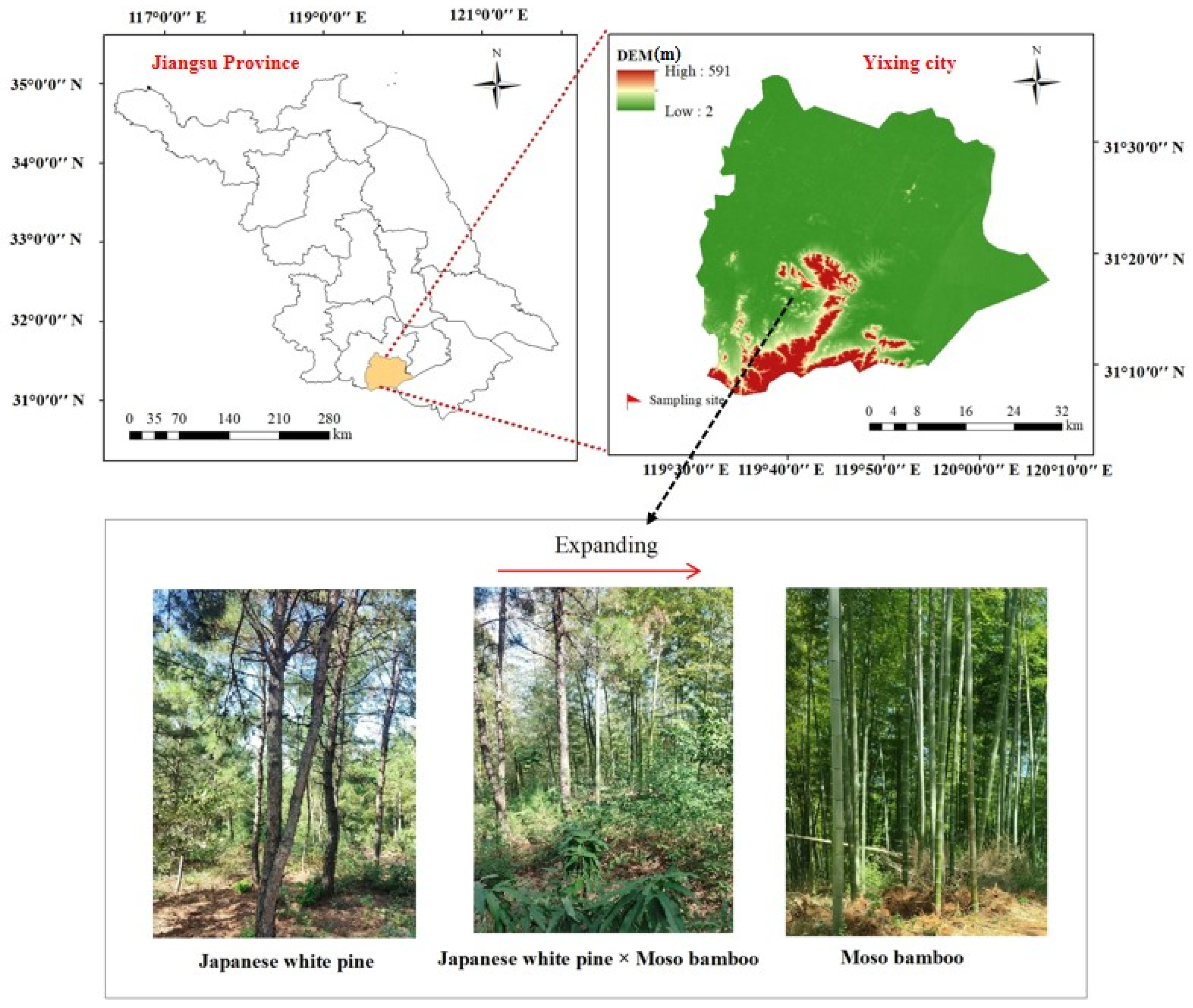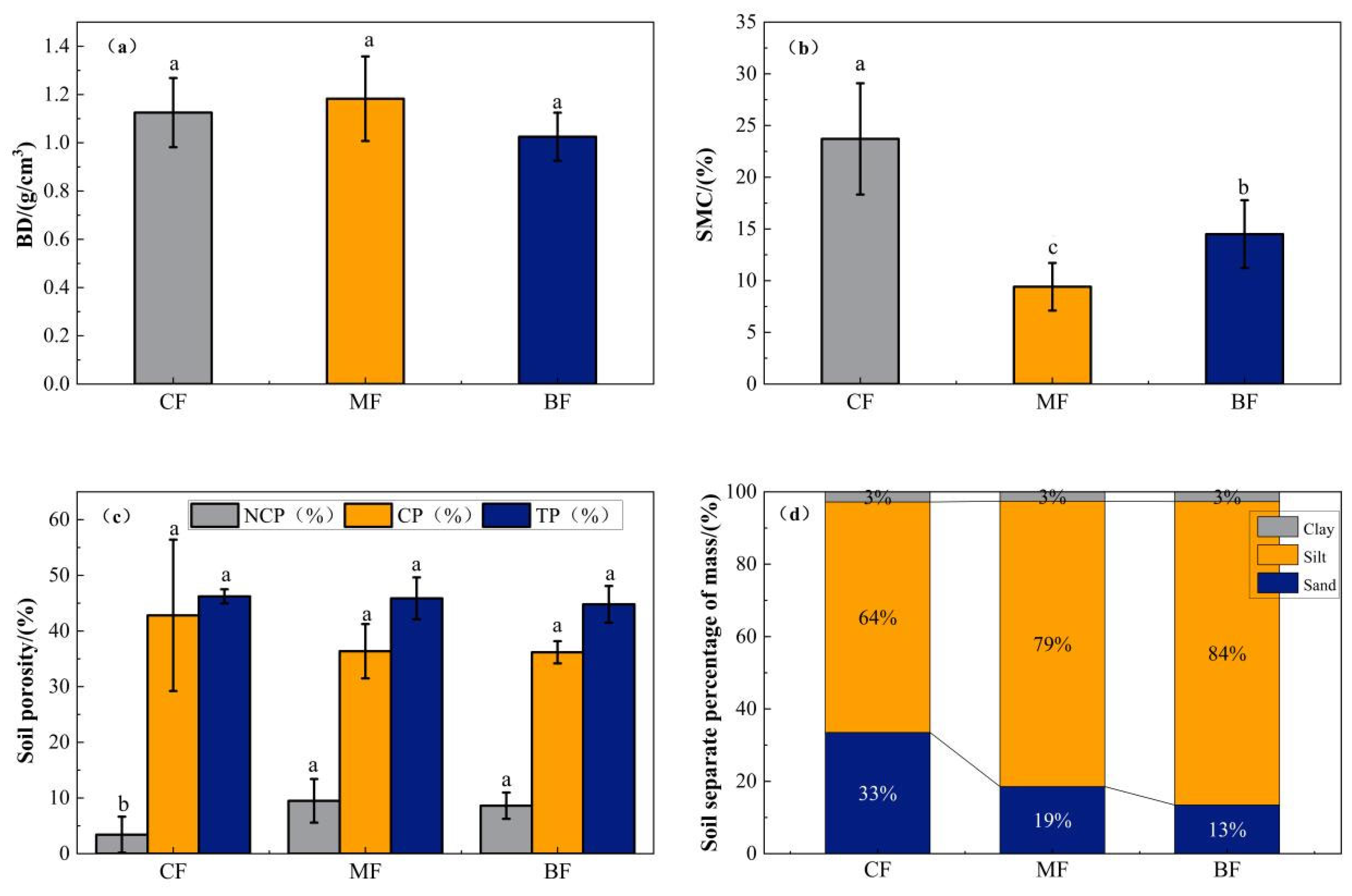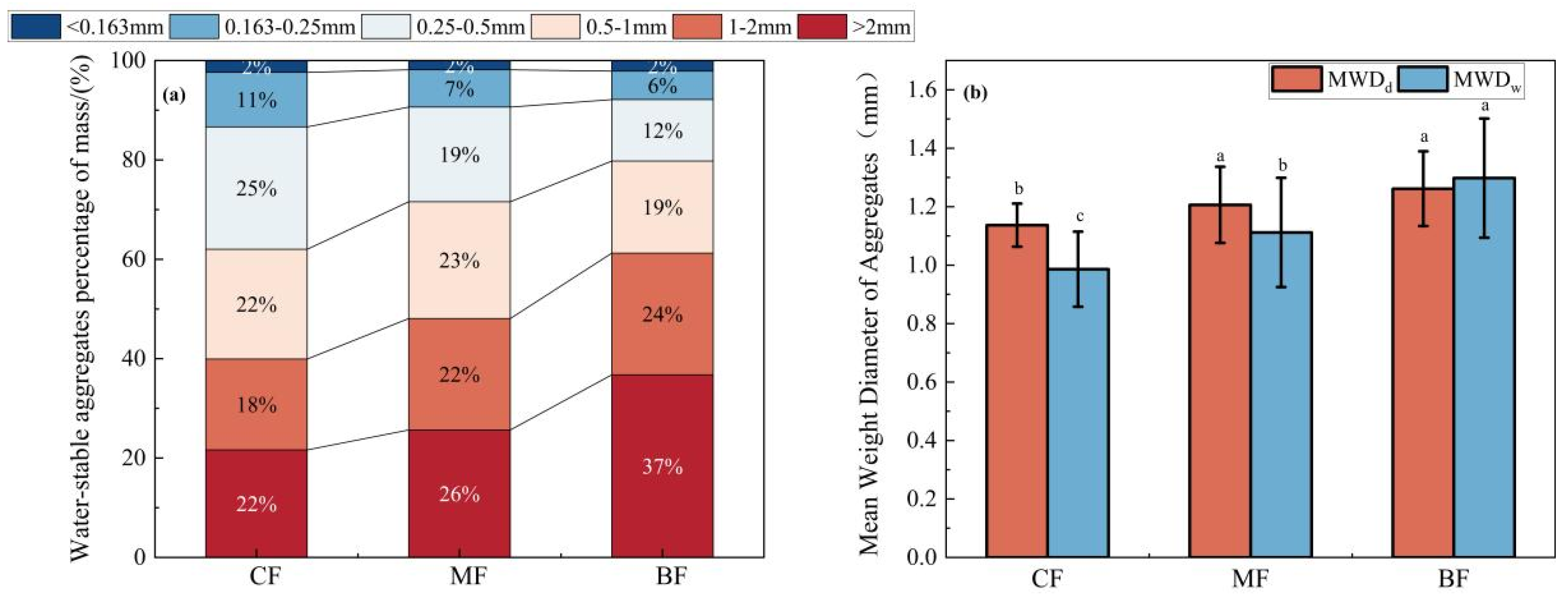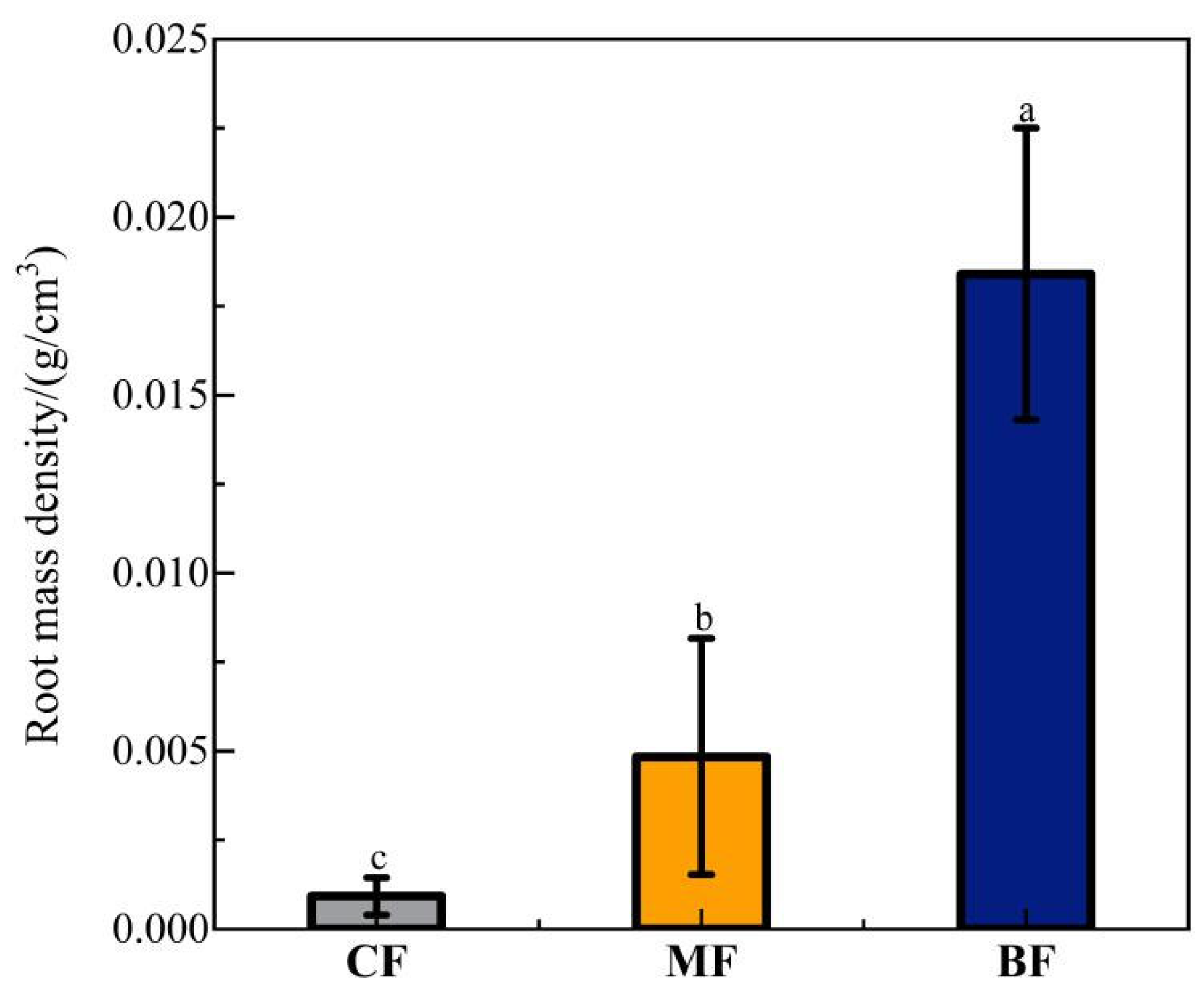Peak Soil Erosion Risk in Mixed Forests: A Critical Transition Phase Driven by Moso Bamboo Expansion
Abstract
1. Introduction
2. Materials and Methods
2.1. Study Area Description
2.2. Sample Site and Soil Sample Collection
2.3. Determination of Soil Detachment Capacity
2.4. Determination of Soil Properties and Root Traits
- (1)
- Physical properties
- (2)
- Soil chemical properties
- (3)
- Root system characterization
2.5. Statistical Analysis
3. Results
3.1. Impact of the Expansion of Bamboo Forests to Coniferous Forests on Soil Physical Properties
3.2. Impact of the Expansion of Bamboo Forests to Coniferous Forests on Soil Chemical Properties and Root Characteristics
3.3. Characteristics and Influencing Factors of Soil Detachment Capacity
4. Discussion
4.1. Effects of Soil Properties and Root Traits on Soil Detachment Capacity
4.2. Effects of the Invasion of Bamboo Forests on Soil Detachment Capacity
4.3. Limitations and Significance of This Study
5. Conclusions
- (1)
- Moso bamboo expansion significantly altered soil structure and nutrient stoichiometric characteristics: The MF stage exhibited the highest soil bulk density (1.13 g·cm−3), with non-capillary porosity increasing markedly with bamboo expansion (reaching 0.10% in MF). The mean weight diameter (MWD) of soil aggregates demonstrated a 12.1% enhancement in the MF compared to the CF, though the MF still demonstrated lower structural stability than the BF. Soil nutrients exhibited stage-dependent variations during bamboo expansion: Total phosphorus (P) content decreased during the MF stage (14.08 g·kg−1); in comparison ammonium nitrogen (NH4+-N) content increased significantly in the BF stage (14.24 mg·kg−1). The carbon-to-nitrogen ratio (C/N) exhibited a 28.3% reduction during the transition from the MF to BF. Furthermore, root mass density (RMD) demonstrated spatial differentiation, with the BF displaying the highest values (3.12 kg·m−3), significantly exceeding those in the MF (2.05 kg·m−3) and CF (1.78 kg·m−3) during the expansion process.
- (2)
- During the expansion of moso bamboo into this CF, Dc demonstrated a significant nonlinear response, reaching its peak (0.034 kg·m−2·s−1) during the MF stage. This value was notably higher than that observed in the CF (0.023 kg·m−2·s−1) and BF (0.018 kg·m−2·s−1).
- (3)
- Our PLS-SEM analysis results confirmed that soil moisture content and soil total nitrogen exert primary direct effects on Dc. In comparison, root characteristics exerted indirect effects on Dc by modulating soil properties.
Author Contributions
Funding
Data Availability Statement
Acknowledgments
Conflicts of Interest
Nomenclature
| Dc | Soil detachment capacity |
| CF | Japanese white pine forest |
| BF | Moso bamboo forest |
| MF | Moso bamboo–Japanese white pine mixed forest |
| MWD | Average mass diameter of soil aggregates |
| PLS-SEM | Partial Least Squares Structural Equation Modeling |
| ANOVA | One-way analysis of variance |
References
- Lima, R.A.F.; Rother, D.C.; Muler, A.E.; Lepsch, I.F.; Rodrigues, R.R. Bamboo Overabundance Alters Forest Structure and Dynamics in the Atlantic Forest Hotspot. Biol. Conserv. 2012, 147, 32–39. [Google Scholar] [CrossRef]
- Chen, X.; Liu, Y. Effects of Moso Bamboo (Phyllostachys pubescens) Expansion on the Stock and Nutrient Characteristics of the Litter Layer in Subtropical Coniferous and Broad-Leaved Mixed Forests, China. Forests 2024, 15, 342. [Google Scholar] [CrossRef]
- Shinohara, Y.; Misumi, Y.; Kubota, T.; Nanko, K. Characteristics of Soil Erosion in a Moso-Bamboo Forest of Western Japan: Comparison with a Broadleaved Forest and a Coniferous Forest. CATENA 2019, 172, 451–460. [Google Scholar] [CrossRef]
- Shinohara, Y.; Otsuki, K. Comparisons of Soil-Water Content between a Moso Bamboo (Phyllostachys pubescens) Forest and an Evergreen Broadleaved Forest in Western Japan. Plant Species Biol. 2015, 30, 96–103. [Google Scholar] [CrossRef]
- Liu, C.X.; Zheng, C.Y.; Wang, L.; Zhang, J.; Wang, Q.; Shao, S.; Qin, H.; Xu, Q.F.; Liang, C.F.; Chen, J.H. Moso Bamboo Invasion Changes the Assembly Process and Interactive Relationship of Soil Microbial Communities in a Subtropical Broadleaf Forest. For. Ecol. Manag. 2023, 536, 120901. [Google Scholar] [CrossRef]
- Jiang, R.; Lin, J.Y.; Zhang, X.W.; Kang, M.Q. Investigating Changes of Forest Aboveground Biomass Induced by Moso Bamboo Expansion with Terrestrial Laser Scanner. Ecol. Inform. 2024, 83, 102812. [Google Scholar] [CrossRef]
- Bai, S.B.; Conant, R.T.; Zhou, G.M.; Wang, Y.X.; Wang, N.; Li, Y.H.; Zhang, K.Q. Effects of Moso Bamboo Encroachment into Native, Broad-Leaved Forests on Soil Carbon and Nitrogen Pools. Sci. Rep. 2016, 6, 31480. [Google Scholar] [CrossRef]
- Liu, J.Y.; Liao, H.X.; Fan, M.H.; Zhou, T.; Peng, S.L. Comparison of Root Morphology and Rhizosphere Microbial Communities Form Moso-bamboo in Different Forest Types. Ecol. Evol. 2023, 13, e10153. [Google Scholar] [CrossRef] [PubMed]
- Chen, Q.; Zou, Q.; Liu, Y.Q.; Lan, L.Y.; Mo, X.Y.; Gao, Y.Y.; Yuan, X.; Huang, J.H.; Fu, X.B.; Li, L.H.; et al. Analysis on the Transpiration Response of Japanese Cedar (Crytomeria fortunei) and Influencing Factors after Expansion of Moso Bamboo (Phyllostachys edulis). Ecol. Indic. 2023, 154, 110636. [Google Scholar] [CrossRef]
- Yan, J.X.; Zhang, K.D.; Chen, J.Y.; Wang, Y.X.; Liu, L.J.; Liu, J.J. Effects of Different Land-Use Types on Soil Detachment Capacity in Loess Areas. CATENA 2024, 247, 108523. [Google Scholar] [CrossRef]
- Ma, J.Y.; Li, Z.B.; Ma, B.; Wang, C.G.; Sun, B.Y.; Shang, Y.Z. Response Mechanism of the Soil Detachment Capacity of Root-Soil Composites across Different Land Uses. Soil Tillage Res. 2022, 224, 105501. [Google Scholar] [CrossRef]
- Parhizkar, M.; Shabanpour, M.; Zema, D.A.; Lucas-Borja, M.E. Rill Erosion and Soil Quality in Forest and Deforested Ecosystems with Different Morphological Characteristics. Resources 2020, 9, 129. [Google Scholar] [CrossRef]
- Wang, B.; Li, P.P.; Huang, C.H.; Liu, G.B.; Yang, Y.F. Effects of Root Morphological Traits on Soil Detachment for Ten Herbaceous Species in the Loess Plateau. Sci. Total Environ. 2021, 754, 142304. [Google Scholar] [CrossRef] [PubMed]
- Zi, R.Y.; Zhao, L.S.; Fang, Q.; Qian, X.H.; Fang, F.Y.; Fan, C.H. Path Analysis of the Effects of Hydraulic Conditions, Soil Properties and Plant Roots on the Soil Detachment Capacity of Karst Hillslopes. CATENA 2023, 228, 107177. [Google Scholar] [CrossRef]
- Parhizkar, M.; Nasiri, M.R. Modeling Root Effects on Soil Detachment Capacity Using Critical Flow Depth and Unit Energy of Cross Section in Soils under Fraxinus excelsior L. Species. Rhizosphere 2024, 32, 100990. [Google Scholar] [CrossRef]
- Demenois, J.; Carriconde, F.; Bonaventure, P.; Maeght, J.-L.; Stokes, A.; Rey, F. Impact of Plant Root Functional Traits and Associated Mycorrhizas on the Aggregate Stability of a Tropical Ferralsol. Geoderma 2018, 312, 6–16. [Google Scholar] [CrossRef]
- Hao, H.X.; Qin, J.H.; Sun, Z.X.; Guo, Z.L.; Wang, J.G. Erosion-Reducing Effects of Plant Roots during Concentrated Flow under Contrasting Textured Soils. CATENA 2021, 203, 105378. [Google Scholar] [CrossRef]
- Hao, H.X.; Di, H.Y.; Jiao, X.; Wang, J.G.; Guo, Z.H.; Shi, Z.H. Fine Roots Benefit Soil Physical Properties Key to Mitigate Soil Detachment Capacity Following the Restoration of Eroded Land. Plant Soil 2020, 446, 487–501. [Google Scholar] [CrossRef]
- Garcia, L.; Damour, G.; Gary, C.; Follain, S.; Le Bissonnais, Y.; Metay, A. Trait-Based Approach for Agroecology: Contribution of Service Crop Root Traits to Explain Soil Aggregate Stability in Vineyards. Plant Soil 2019, 435, 1–14. [Google Scholar] [CrossRef]
- Erktan, A.; Cécillon, L.; Graf, F.; Roumet, C.; Legout, C.; Rey, F. Increase in Soil Aggregate Stability along a Mediterranean Successional Gradient in Severely Eroded Gully Bed Ecosystems: Combined Effects of Soil, Root Traits and Plant Community Characteristics. Plant Soil 2016, 398, 121–137. [Google Scholar] [CrossRef]
- Parhizkar, M.; Shabanpour, M.; Miralles, I.; Cerdà, A.; Tanaka, N.; Asadi, H.; Lucas-Borja, M.E.; Zema, D.A. Evaluating the Effects of Forest Tree Species on Rill Detachment Capacity in a Semi-Arid Environment. Ecol. Eng. 2021, 161, 106158. [Google Scholar] [CrossRef]
- Zeng, X.X.; Luo, H.T.; Lu, J.; Zhu, X.L.; He, Y.L.; Gong, C.; Ren, Z.W.; Huang, D.M.; Song, Q.N.; Yang, Q.P. The Process of Patchy Expansion for Bamboo (Phyllostachys edulis) at the Bamboo–Broadleaf Forest Interface: Spreading and Filling in Order. Forests 2024, 15, 438. [Google Scholar] [CrossRef]
- Ali, H.E.; Reineking, B.; Münkemüller, T. Effects of Plant Functional Traits on Soil Stability: Intraspecific Variability Matters. Plant Soil 2017, 411, 359–375. [Google Scholar] [CrossRef]
- Umemura, M.; Takenaka, C. Changes in Chemical Characteristics of Surface Soils in Hinoki Cypress (Chamaecyparis obtusa) Forests Induced by the Invasion of Exotic Moso Bamboo (Phyllostachys pubescens) in Central Japan. Plant Species Biol. 2015, 30, 72–79. [Google Scholar] [CrossRef]
- Song, Q.N.; Ouyang, M.; Yang, Q.P.; Lu, H.; Yang, G.Y.; Chen, F.S.; Shi, J.M. Degradation of Litter Quality and Decline of Soil Nitrogen Mineralization after Moso Bamboo (Phyllostachys pubscens) Expansion to Neighboring Broadleaved Forest in Subtropical China. Plant Soil 2016, 404, 113–124. [Google Scholar] [CrossRef]
- Teng, Q.M.; Lu, X.N.; Zhang, Q.Q.; Cai, L.L.; Sardar, M.F.; Li, Y.F.; Abbas, T.; Li, Y.; Chang, S.X.; Li, Y.C. Litterfall Quality Modulates Soil Ammonium and Nitrate Supply through Altering Microbial Function in Bamboo Encroachment of Broadleaf Forests. Geoderma 2023, 437, 116592. [Google Scholar] [CrossRef]
- Ministry of Civil Affairs of the People’s Republic of China; Huang, S.X.; Hou, X.Y. Administrative Divisions Compendium of the People’s Republic of China: Jiangsu Volume; China Society Press: Beijing, China, 2014; pp. 2062–2063. [Google Scholar]
- Zhu, X.A.; Liu, W.J.; Jiang, X.J.; Wang, P.Y.; Li, W.X. Effects of Land-use Changes on Runoff and Sediment Yield: Implications for Soil Conservation and Forest Management in Xishuangbanna, Southwest China. Land Degrad. Dev. 2018, 29, 2962–2974. [Google Scholar] [CrossRef]
- Ouyang, M.; Tian, D.; Pan, J.M.; Chen, G.P.; Su, H.J.; Yan, Z.B.; Yang, Q.P.; Ji, C.J.; Tang, Z.Y.; Fang, J.Y. Moso Bamboo (Phyllostachys edulis) Invasion Increases Forest Soil pH in Subtropical China. CATENA 2022, 215, 106339. [Google Scholar] [CrossRef]
- Yang, C.B.; Ni, H.J.; Zhong, Z.K.; Zhang, X.P.; Bian, F.Y. Changes in Soil Carbon Pools and Components Induced by Replacing Secondary Evergreen Broadleaf Forest with Moso Bamboo Plantations in Subtropical China. CATENA 2019, 180, 309–319. [Google Scholar] [CrossRef]
- Yuan, X.B.; Niu, D.C.; Wang, Y.; Boydston, A.; Guo, D.; Li, X.D.; Wen, H.Y.; Qin, Y.; Fu, H. Litter Decomposition in Fenced and Grazed Grasslands: A Test of the Home-Field Advantage Hypothesis. Geoderma 2019, 354, 113876. [Google Scholar] [CrossRef]
- Li, N.; Guo, C.L.; Wang, Y.; Gao, T.Y.; Yang, J.F.; Han, X.R. Effects of Long-Term Fertilization on Potassium Fixation Capacity in Brown Soil. IOP Conf. Ser. Earth Environ. Sci. 2018, 108, 032036. [Google Scholar] [CrossRef]
- Ce, H.; Xie, L.; Rumin, Z.; Guosheng, W. Diurnal Variation of Phyllostachys edulis Photosynthesis and Transpiration during Its Rapid Growth Period. J. Zhejiang AF Univ. 2018, 35, 277–283. (In Chinese) [Google Scholar]
- Hu, Y.G.; Zheng, J.l.; Pan, Q.M.; Jin, K.; Li, Y.Y. Effects of water stress on photosynthetic characteristics and chlorophyll fluorescence parameters of tea seedlings. J. Drain. Irrig. Mach. Eng. JDIME 2025, 43, 826–832. [Google Scholar]
- Xu, Q.F.; Jiang, P.K.; Wu, J.S.; Zhou, G.M.; Shen, R.F.; Fuhrmann, J.J. Bamboo Invasion of Native Broadleaf Forest Modified Soil Microbial Communities and Diversity. Biol. Invasions 2015, 17, 433–444. [Google Scholar] [CrossRef]
- Xiao, H.F.; Liu, J.H.; Li, F. Both Alpha and Beta Diversity of Nematode Declines in Response to Moso Bamboo Expansion in South China. Applied Soil Ecology 2023, 183, 104761. [Google Scholar] [CrossRef]
- Wu, Y.X.; Guo, J.H.; Tang, Z.Y.; Wang, T.X.; Li, W.T.; Wang, X.R.; Cui, H.X.; Hu, X.Y.; Qi, L.H. Moso Bamboo (Phyllostachys edulis) Expansion Enhances Soil pH and Alters Soil Nutrients and Microbial Communities. Sci. Total Environ. 2024, 912, 169346. [Google Scholar] [CrossRef]
- Chou, C.H.; Yang, C.M. Allelopathic Research of Subtropical Vegetation in Taiwan II. Comparative Exclusion of Understory by Phyllostachys edulis and Cryptomeria japonica. J. Chem. Ecol. 1982, 8, 1489–1507. [Google Scholar] [CrossRef] [PubMed]
- Ma, Q.H.; Zhang, K.L.; Cao, Z.H.; Yang, Z.C.; Wei, M.Y.; Gu, Z.K. Impacts of Different Surface Features on Soil Detachment in the Subtropical Region. Int. Soil Water Conserv. Res. 2021, 9, 555–565. [Google Scholar] [CrossRef]
- Li, Q.; Liu, G.B.; Zhang, Z.; Tuo, D.F.; Bai, R.R.; Qiao, F.F. Relative Contribution of Root Physical Enlacing and Biochemistrical Exudates to Soil Erosion Resistance in the Loess Soil. CATENA 2017, 153, 61–65. [Google Scholar] [CrossRef]
- Li, X.R.; Hui, R.; Tan, H.J.; Zhao, Y.; Liu, R.T.; Song, N.P. Biocrust Research in China: Recent Progress and Application in Land Degradation Control. Front. Plant Sci. 2021, 12, 751521. [Google Scholar] [CrossRef]
- Chaparro, M.A.E.; Moralejo, M.D.P.; Böhnel, H.N.; Acebal, S.G. Iron Oxide Mineralogy in Mollisols, Aridisols and Entisols from Southwestern Pampean Region (Argentina) by Environmental Magnetism Approach. CATENA 2020, 190, 104534. [Google Scholar] [CrossRef]
- Wang, C.G.; Li, H.R.; Xue, S.B.; Ma, B.; Shang, Y.Z.; Li, Z.B. How Root and Soil Properties Affect Soil Detachment Capacity in Different Grass–Shrub Plots: A Flume Experiment. CATENA 2023, 229, 107221. [Google Scholar] [CrossRef]
- Zhang, Y.; Cai, J.F.; Wan, Y.; Gao, H.Y.; Sun, K.; Shen, Y.L.; Siha, A.; Li, H.L. Effects of Eichhornia crassipes invasion degree on the growth traits and inter-specfic relationship between Ceratophyllum demersum and Hydrilla verticillata. Acta Ecol. Sin. 2022, 42, 6863–6873. (In Chinese) [Google Scholar] [CrossRef]






| Plot Type | Plot Number | Elevation (m) | Dominant Tree Species | Stem Count | DBH (cm) |
|---|---|---|---|---|---|
| CF | Plot 1 | 189.7 | Japanese white pine | 6 | 18.62 ± 14.93 |
| Plot 2 | 190.7 | Japanese white pine | 13 | 49.93 ± 10.42 | |
| Plot 3 | 186.9 | Japanese white pine | 12 | 59.42 ± 11.40 | |
| MF | Plot 4 | 184.5 | Moso bamboo, Japanese white pine | 6, 7 | 24 ± 3.46, 58 ± 10.53 |
| Plot 5 | 185.0 | Moso bamboo, Japanese white pine | 10, 8 | 29 ± 1.41, 63.26 ± 16.26 | |
| Plot 6 | 187.0 | Moso bamboo, Japanese white pine | 10, 10 | 27 ± 5.16, 49.5 ± 10.61 | |
| BF | Plot 7 | 173.6 | Moso bamboo | 33 | 37.5 ± 3.73 |
| Plot 8 | 177.0 | Moso bamboo | 22 | 38.67 ± 2.52 | |
| Plot 9 | 174.9 | Moso bamboo | 23 | 40 ± 3.29 |
| Indexes | CF | MF | BF |
|---|---|---|---|
| pH | 4.17 ± 0.10 c | 5.16 ± 0.08 b | 5.41 ± 0.06 a |
| SOC (g·kg−1) | 3.46 ± 0.85 a | 2.75 ± 0.64 b | 2.59 ± 0.47 b |
| N (g·kg−1) | 0.17 ± 0.03 a | 0.13 ± 0.02 b | 0.19 ± 0.04 a |
| P (g·kg−1) | 18.00 ± 5.24 a | 14.08 ± 2.74 b | 12.42 ± 1.25 b |
| K (g·kg−1) | 22.16 ± 8.17 a | 23.66 ± 8.78 a | 18.42 ± 9.22 a |
| NH4+-N (mg·kg−1) | 7.65 ± 3.56 b | 8.13 ± 1.79 b | 14.24 ± 6.72 a |
| AP (mg·kg−1) | 7.91 ± 1.13 a | 7.67 ± 1.31 a | 8.03 ± 1.23 a |
| AK (mg·kg−1) | 104.5 ± 8.15 a | 103.6 ± 11.49 a | 105.12 ± 13.66 a |
| C/N | 19.86 ± 3.71 a | 20.89 ± 3.01 a | 14.22 ± 3.37 b |
Disclaimer/Publisher’s Note: The statements, opinions and data contained in all publications are solely those of the individual author(s) and contributor(s) and not of MDPI and/or the editor(s). MDPI and/or the editor(s) disclaim responsibility for any injury to people or property resulting from any ideas, methods, instructions or products referred to in the content. |
© 2025 by the authors. Licensee MDPI, Basel, Switzerland. This article is an open access article distributed under the terms and conditions of the Creative Commons Attribution (CC BY) license (https://creativecommons.org/licenses/by/4.0/).
Share and Cite
Wang, J.; Wang, X.; Yan, Y.; Wang, L.; Hu, H.; Ma, B.; Zhou, H.; Liu, J.; Gan, F.; Fan, Y. Peak Soil Erosion Risk in Mixed Forests: A Critical Transition Phase Driven by Moso Bamboo Expansion. Agriculture 2025, 15, 1772. https://doi.org/10.3390/agriculture15161772
Wang J, Wang X, Yan Y, Wang L, Hu H, Ma B, Zhou H, Liu J, Gan F, Fan Y. Peak Soil Erosion Risk in Mixed Forests: A Critical Transition Phase Driven by Moso Bamboo Expansion. Agriculture. 2025; 15(16):1772. https://doi.org/10.3390/agriculture15161772
Chicago/Turabian StyleWang, Jie, Xin Wang, Youjin Yan, Liangjie Wang, Haibo Hu, Bing Ma, Hongwei Zhou, Jiacai Liu, Fengling Gan, and Yuchuan Fan. 2025. "Peak Soil Erosion Risk in Mixed Forests: A Critical Transition Phase Driven by Moso Bamboo Expansion" Agriculture 15, no. 16: 1772. https://doi.org/10.3390/agriculture15161772
APA StyleWang, J., Wang, X., Yan, Y., Wang, L., Hu, H., Ma, B., Zhou, H., Liu, J., Gan, F., & Fan, Y. (2025). Peak Soil Erosion Risk in Mixed Forests: A Critical Transition Phase Driven by Moso Bamboo Expansion. Agriculture, 15(16), 1772. https://doi.org/10.3390/agriculture15161772







